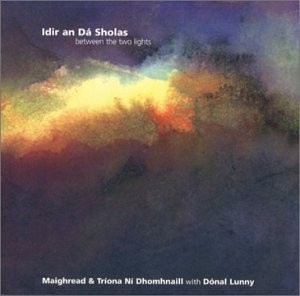 Brendan Foreman penned this review.
Brendan Foreman penned this review.
One half of this duo of sisters is actually quite prominent in the world of Irish traditional music. Triona Dhomhnaill was a founding member of three of the most important modern-day Celtic musical groups: the Bothy Band, Touchstone, and Nightnoise. Triona has now teamed up with her sister, Maighread, to record a modern-sounding set of very traditional Irish songs. Triona has always done well teaming up with family members (her brother Micheal was also a founding member of Touchstone and Nightnoise), but the music that she has created here with Maighread resonates with passion and beauty. Backed up and produced by Donal Lunny, Idir an Da Sholas is testament to the emotional power that these 100+ year-old songs can still generate.
All of the tracks on this CD are traditional songs collected over the years by the various Dhomhnaills throughout Ireland. But their harmonization and instrumentation give the music a thoroughly modern veneer, creating a shimmering, ethereal sound that will be instantly recognizable by any fan of Nightnoise, Relativity, or even later Clannad.
The tunes of most of the songs here are simple and slow, qualities which allow the two Dhomhnaill sisters to showcase their clearly substantial vocal talents. Unlike many a singer of traditional Irish music, Maighread and Triona do not over-emote, but exhibit the emotions of the songs through clarity and often exquisite intonation. Even for veterans, it is hard to match this level of precision and beauty in song.
The CD begins a contemplative, almost nostalgic version of “The Spanish Lady,” sung by the sisters by the wistfulness of an old man looking back at his adventure-filled life with both fondness and sadness. Although this track has more instrumental back-up that most — keyboard, bouzouki, bodhran, guitar, fiddle, et al., it is done with such grace and discretion that the listener almost doesn’t notice.
This rather unsettling feeling of both happiness and mourning is found throughout the CD. In “Liostail me le Sairsint (I Listed with a Sergeant),” the narrator — here sung in duet-style by both sisters — recalls both the glory and suffering of the Irish army enlistee, whereas in “Donall Og” the narrator first praises the aspects of her love, only to curse the burdens that that love has given her. Even a song of supposed reunited love such as “The Banks of Claudy,” in which a man tests the integrity of his woman’s love and she passes with flying colors, is given an uneasy hint of disharmony by a particularly bitter-sounding vocal style.
Other songs are slightly more straightforward in their presentation. “Bruach na Carraige Baine” is a starkly played song of seduction from County Cork, sung solo by Maighread. The fast-paced chorus song “Nil se ina la (It’s not the dawn of the day at all)” details the ribald adventures of the people attending a particular fair. The narrator of “Sandy Hills of Ceann Dubhrann” mourns the fact that he will soon ship out to sea, while the singer of “Ar a dhul chun an chuain dom (Going down by the sea)” has found trouble just by walking into a port town.
Another powerful sea song is “Foireann an Bhaid (The Best Crew of Men).” Based apparently on a real shipwreck, the song describes each individual member of the crew, who they were and what kind of lives they led on land. The Domhnaills follow such mournfulness with the much more uptempo “Faoitin (Whitin’)” about the merriness of living in a fishing town.
The sisters end the CD with a couple of strange tracks. “Pill, Pill a Ruin o (Turn, turn my dear)” is a bitter invective against someone who has left the Catholic priesthood for a ministership in the Church of Ireland. “Tidy Ann” is a lighthearted romp about the attempted suit of a frog against a mouse and the chaos that ensues when cats get involved.
(Green Linnet, 2000)
[
